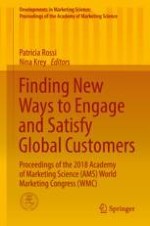
2019 | OriginalPaper | Chapter
Examining the Impact of Provocation in Green Advertising on Consumers’ Attitudes and Perceptions
Authors : Samer Elhajjar, Sihem Dekhili
Published in: Finding New Ways to Engage and Satisfy Global Customers
Publisher: Springer International Publishing
Activate our intelligent search to find suitable subject content or patents.
Select sections of text to find matching patents with Artificial Intelligence. powered by
Select sections of text to find additional relevant content using AI-assisted search. powered by